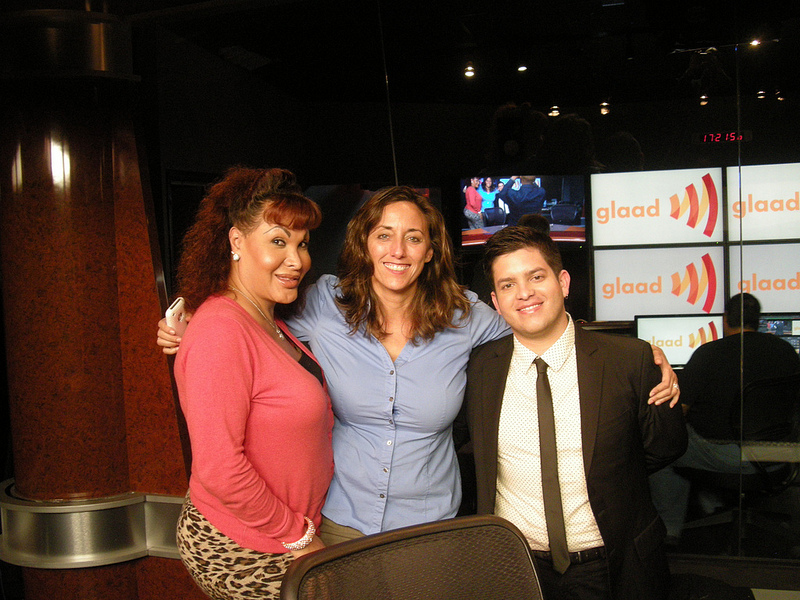Last month I was in Los Angeles for the first time. I attended GLAAD's second edition of the National People of Color Media Institute, an awesome project GLAAD launched to bring together lesbian, gay, bisexual, transgender people of color working on different issues and in different communities, have them share their experiences, and enhance their potential as advocates and spokespeople for those communities. The aim of GLAAD through this institute and their Voices of Color program, led by Daryl Hannah, is to bring more Black, Latino, and Asian faces to our newspapers, magazines, blogs, radio and television shows. I was honored to be the first non-U.S. resident who participated.

Brenda del Rio from Bienestar, GLAAD's Monica Trasandes, and Enrique Torre Molina.
The work GLAAD has done to make media a more inclusive space for LGBT people (in the U.S. and increasingly elsewhere), and to make LGBT stories more present and powerful in that media for almost 30 years, cannot be understated. However, LGBT people of color are not visible enough on mainstream media. And I would say not even on LGBT media. Look at, for example, gay characters who are on TV shows right now: Louis on Partners, Kurt on Glee, Bryan on The New Normal, Cam and Mitch on Modern Family. All white guys.
According to The Opportunity Agenda's Public Opinion and Discourse on the Intersections of LGBT Issues and Race 2012 report, LGBT issues are under-reported in Latino media in the U.S., although California's Proposition 8 in 2008 drove those media to have a wider coverage of LGBT issues. Not surprising, considering the large population of Latinos in the state. The report also points out that much "of the anti-LGBT rhetoric, slurs, and derogatory language found in this media scan come from users' online comments, not from the media themselves." When I blogged for VivirMexico.com, I would often get very homophobic, moronic comments from readers, such as "Fags are shitty people. Fags themselves are to be blamed of being discriminated against. Their attitude is annoying and some times disrespectful. If they're fags I don't care. Fuck with each other and that's it, but the sissy ones are disgusting."
I have a hard time translating the concept of "people of color" with all its heavy, powerful meaning to our experience in Mexico. Race and racism are not topics present on the media, much less on off-screen daily conversations. We often think of Mexico as a racism-free society. But the strongest form of discrimination against black people, for example, is not ignoring their exclusion but actually thinking there aren't any here, except for the occasional model on a Mexico City fashion week runway. The National Council to Prevent Discrimination (Conapred) has done research and spread information on discrimination against people of African descent. Other than that, they are practically invisible. According to Jonathan Orozco, a communication staffer at Conapred, there are no official numbers on the African descent community living in Mexico. Same goes for LGBTs, by the way: we don't know exactly how many of us are there, working as what, living where, etc.
Except for a couple of pieces or documentaries on the muxes living in Oaxaca, I can't recall seeing anyone who was LGBT and indigenous on screen. And I don't foresee it happening any time soon, if even bouncers at some gay bars and clubs are responsible for leaving "indigenous-looking" people out.
Growing up in a privileged background, having a mostly harmless coming-out process, being surrounded by other gays and lesbians in my family, and living in the only city in the country where I can marry my boyfriend has let me experience a homophobic society. I can only imagine what things are like for someone on the other end of racist, classist Mexico.
Where are all those faces in the pages of gay magazines, on the ads of hookup websites, on TV shows? For a group that is such a target of bigotry, we as LGBT media could do a lot better to address those other types of exclusion happening within our community.